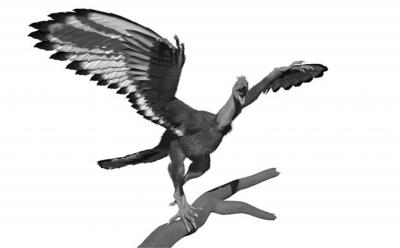
A transitional species that represents a link between dinosaurs and birds may have sported pale feathers that were dark at the tips, a new study suggests.
For the study, detailed in the June 13 issue of the Journal of Analytical Atomic Spectrometry, researchers used an X-ray beam to identify ancient traces of pigment in fossils of Archaeopteryx, a winged creature that lived about 150 million years ago.
"This work refines our understanding of pigment patterning in perhaps the most important known fossil. Our technique shows that complex patterns were present even at the very earliest steps in the evolution of birds," said study co-author Roy Wogelius, an earth scientist at Manchester University in the United Kingdom, in a statement.
Rare bird
Archaeopteryx was a transitional species between dinosaurs and birds that lived in what is now Germany. Scientists believe birds evolved from theropods, a group of carnivorous dinosaurs taht includes the Tyrannosaurus rex, during the Jurassic Era, about 150 million years ago.
Only 11 fossils specimens of the elusive creature have been found, and scientists thought any traces of the dinobird's feathers had long since vanished. [Avian Ancestors: Dinosaurs That Learned to Fly]
But recently, researchers discovered that some fossilized feathers contained traces of melanosomes, pigment-making structures. Last year, researchers analyzed some of these melanosomes and determined that Archaeopteryx sported black feathers.
Sign up for the Live Science daily newsletter now
Get the world’s most fascinating discoveries delivered straight to your inbox.
However, the team sampled just a few spots on the feather, meaning the dinobird's full plumage pattern was still unknown.
To get a more complete picture of the dinobird, Wogelius and his colleagues used an X-ray beam from a synchrotron radiation light source to do a complete scan of a fossilized Archaeopteryx feather, as well as pigmentation found in the surrounding rock.
The team discovered trace amounts of chemicals associated with pigments, which enabled a reconstruction of the animals' feather pattern.
Instead of being all black, it turns out Archaeopteryx sported light-and-dark patterned plumage.
"The fact that these compounds have been preserved in-place for 150 million years is extraordinary," said study co-author Phillip Manning, a paleontologist at the University of Manchester, in a statement. "Together, these chemical traces show that the feather was light in color with areas of darker pigment along one edge and on the tip. Scans of a second fossilized Archaeopteryx, known as the Berlin counterpart, also show that the trace-metal inventory supported the same plumage pigmentation pattern."
Understanding the plumage patterns could provide insights into courtship rituals, as well as the health and eating habits of these ancient creatures.
Follow Tia Ghose on Twitter and Google+. Follow LiveScience @livescience, Facebook & Google+. Original article on LiveScience.com.

Tia is the managing editor and was previously a senior writer for Live Science. Her work has appeared in Scientific American, Wired.com and other outlets. She holds a master's degree in bioengineering from the University of Washington, a graduate certificate in science writing from UC Santa Cruz and a bachelor's degree in mechanical engineering from the University of Texas at Austin. Tia was part of a team at the Milwaukee Journal Sentinel that published the Empty Cradles series on preterm births, which won multiple awards, including the 2012 Casey Medal for Meritorious Journalism.










